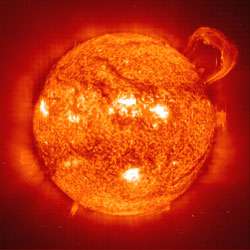Refining the search for new planets

(PhysOrg.com) -- SF State's planet hunting team is trying new avenues of investigation in the quest to discover planets beyond our solar system. At the American Astronomical Society (AAS) meeting in January, graduate students presented novel approaches being used by the Exoplanet Group to search for earth-like planets.
While the search for planets has typically focused on solar-type stars, the Exoplanet Group has begun a new project observing red dwarf stars. Astronomy student Kelsey Clubb shared a poster presentation at the AAS meeting explaining why these cool, low-mass red dwarfs make promising targets.
"We believe that focusing on low-mass stars will lead to the detection of more smaller-mass planets similar to the Earth, and planets with liquid water and temperatures that could sustain life," Clubb said.
Red dwarfs are so faint that they are invisible to the naked eye. However, they are highly suitable for indirect observations because planets orbiting red dwarfs produce a bigger wobble in the host star. Astronomers can detect planets by measuring the gravitational tug that planets exert on their host star, producing a wobble in the star's rotation.
Previous studies of low mass, red dwarf stars show that they are more likely to be accompanied by low mass planets. Since the project began last September the team has identified five red dwarf stars that are prime candidates for further investigation.
Astronomy student Howard Isaacson shared a presentation at the AAS meeting, explaining how his work on stellar activity is aiding planet search efforts. "There can be all kinds of activity in a star's atmosphere such as explosions, flares and solar winds," Isaacson said. "This 'activity' can cause changes in a star's luminosity which could be mistakenly interpreted to indicate the presence of an orbiting planet."
"Howard's work is fundamental to our search for exoplanets because stars that have high activity levels are too 'noisy' for planet searches," said Assistant Professor of Astronomy Debra Fischer, who leads SF State's Exoplanet Group.
At a professional booth hosted by NASA and the Jet Propulsion Laboratory at the AAS meeting, SF State researchers were invited to present a demo version of their planet detection software along with a newly-designed graphical user interface. The graphical user interface (GUI) allows users to analyze data collected from observations of stars to model multiple planet systems.
"Users can enter parameters about their planet search data such as mass and orbital period and they can then see a simple visual simulation of the multiple planet system on the screen," said Julien Spronck, a postdoctoral fellow who worked on the GUI with astronomy students John Brewer and Matt Giguere. "This is a convenient way for people to model multiple planet systems without having to think about the complicated mathematical equations behind the model," Spronck said. The software can manipulate radial velocity data, which measures changes in the star's speed, as well as astrometric data which measures changes in the position of the star.
"The process of fitting data and detecting planets has often been in the hands of a few people in the world," Fischer said. "This software is exciting because it makes it possible for other people to quickly understand the process."
Provided by San Francisco State University



















